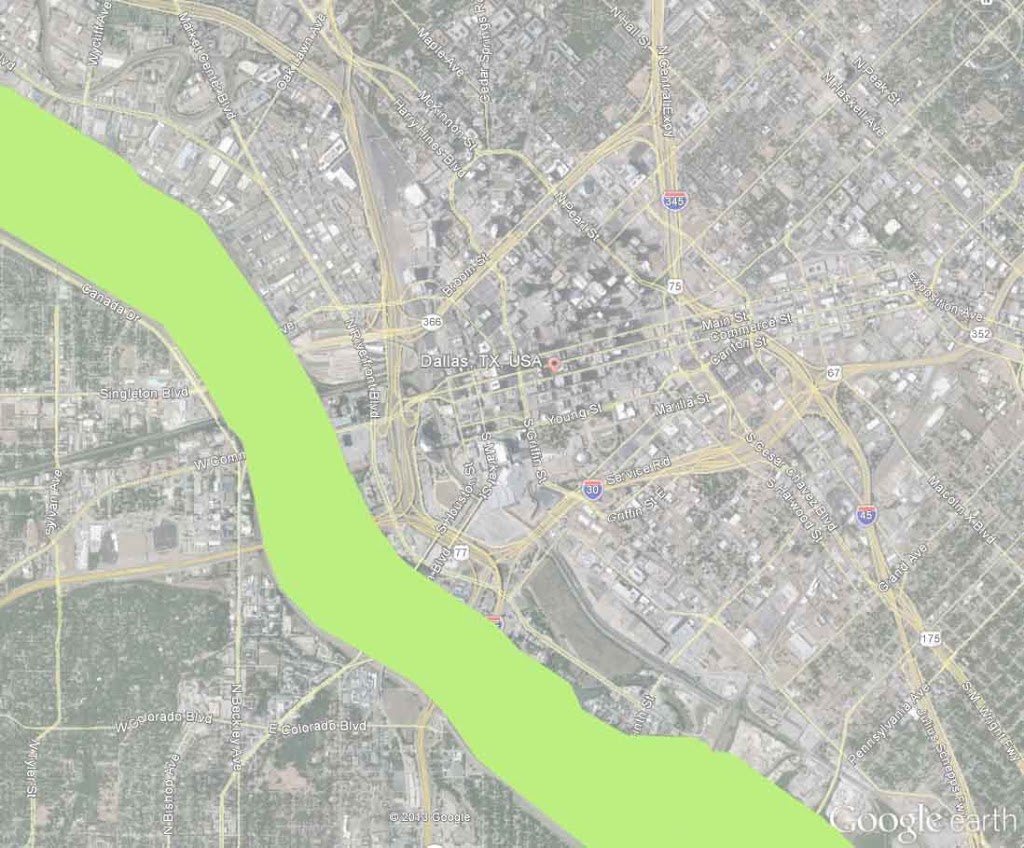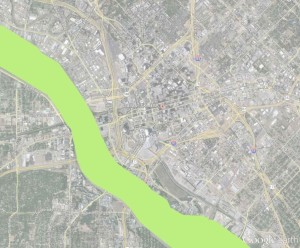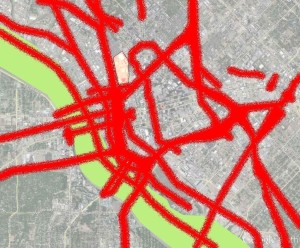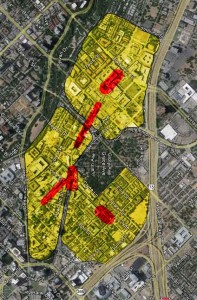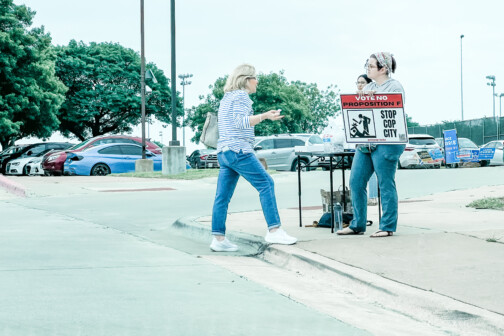The other day, Jim Schutze of the Dallas Observer wrote another piece on the Trinity River Corridor speculating that the Toll Road and everything else to do with the Trinity is a land deal. He’s absolutely right. All of city building is at some root level an exercise in uplift. Except when it fails.
And that the real problem with what all of the planners and business owners focused on the Trinity are getting wrong. That the potential for high-rise exists simply because of the existence of a plan for some kind of waterfront-ish type of park.
Here are the words:
But some people who are experts in those areas think at least some of the Halff concept was right. For example, their renderings showed dense high-rise development along the river. Last week I talked to Larry Beasley of Vancouver, the international city designer who is working on our Trinity River questions in between other things like helping redesignMoscow. In some ways Beasley’s vision of a redeveloped Stemmons corridor mirrored what I saw all those years ago on the conference room walls at Halff.
Beasley said the big thing is being up high enough to be able to see the river over the tops of the levees. Otherwise the river and the greenbelt don’t exist as far as adjacent development is concerned.
“There’s one thing that seems absolutely evident to me,” he said. “The sites near the Trinity need very high density. We need to get buildings up beyond the levees so that from a market point of view you can really enjoy the added value of being adjacent to the Trinity recreation corridor, particularly as it’s further developed.”
What Beasley doesn’t seem to get is that:
- you have to have enough demand to get buildings that tall,
- the economics have to work to finance buildings to construct them that tall (primarily due to point 1,
- the ground plane has to be pleasant enough to help drive demand,
- for the ground plane to be active and pleasant enough, (this is the key point) there has to be enough land available to create a critical mass suitable for a full neighborhood unfractured and fragmented by barriers, and
- rivers are also barriers, though not as destructive to the nearby fabric as highways and railroads.
This is not Vancouver, which made the conscious decision to never allow highways into the city back in the 60’s. Instead, this is a hollowed out Sun Belt city whose fractured and fragmented core provided the chutes and ladders for people to escape the dessicated urban core. This is why I’m particularly and increasingly skeptical of “experts” from out of town, unfamiliar with Sun Belt real estate dynamics. I suspect this contributes to the general supply-side thinking that undermines our efforts towards building a truly vibrant, interconnected city.
“Just build some high-rises like Vancouver (which didn’t have freeways, never hollowed out its core, has amazing urban fabric, a variety of transportation options, and ridiculously beautiful topography) and they will come.” This unfortunately, is the same flawed thinking that fueled Victory, entirely unwitting of its own structural flaws.
All rivers are barriers. This is why we, the royal and historic we, celebrate besting these barriers with bridges and ceremonious architecture. However, even with those bridges, urban rivers still create border vacuums and the vibrancy, density, and demand tends to be on the perpendiculars (those roads linking cores of neighborhoods), not the linears (running along the border vacuum).
The nicer the amenity, the less negative effect this border vacuum will have plus how will connected development will be to said amenity. Unfortunately, all we have is hopes and promises for the Trinity, but even worse than it not being an amenity, is that the areas around it are preposterously fragmented. The single most fragmented area in the city.
Between the existing, proposed, and soon to be underconstruction highways and railroads that carve the city up into little pieces, unable and too small to support life, all of the land on the northeast side of the Trinity is far less valuable than people seem to think it is. No matter what the competition “to connect to the Trinity” thinks is possible. These areas have more global connectivity than they could ever need, but what they lack is local connectivity.
Also, there is the pernicious, deleterious effect of not just the edge condition created by overscaled barriers of “long-trip” infrastructure. It is simply undesirable to be next to highways due to noise, smell, pollution, and unsafety of the physical environment. Furthermore, because the movement patterns are all necessarily car-based, there is intense pressure on the land to support spatially inefficient cars in the way of parking. So you get the eroded edges as shown above.
So let’s compare these areas to Victory, which despite its myriad of flaws and improper planning, its biggest and most decisive was that it was and is, in effect, an island within a sea of cars. Again, it has all the global connectivity any place could ever want, but very little local connectivity. The kind of connectivity that creates the multiplier effect of proximity and clustering. It is entirely drive-to, even for office workers 1/4 mile away in the Crescent. All places need the stabilizing supportive tissue of surrounding neighborhood residential, which is far less susceptible to cannibalization, particularly in outward-pressurized dendritic street networks.
Again, Victory delivered high-rises and density, supply. But, no demand. Why? It has all the same amenities as everywhere else that is near downtown with plenty of “long-trip” infrastructure. What’s missing is the critical mass of area without barrier, the multiplier effect of local connectivity, which makes for desirable places to live, and for others to visit. And thus, stability and demand.
Plopping towers into areas even more fragmented and less connected is flawed from the start. It is strictly supply-sided and as we should have learned, that does nothing for filling up the buildings. Hopefully lenders will realize this soon.
Instead, the future value is in areas of greater critical mass, primarily West and East Dallas, and to a lesser extent, the Cedars. This is why I don’t particularly care about the road. The potential simply doesn’t exist for a Vancouver built along side it. At least not the downtown side.
On the other hand, if we look at the success of uptown, we can see that even though it has a number of barriers (75, the cemetery, Cedar Springs and Turtle Creek) there is still a critical mass where multiple neighborhoods, each with their own center can combine and make something greater than the some of the parts, which in this case, we could deem a district. Or, “uptown.” McKinney, helpfully calmed by the slow moving but lovable MATA trolley, provides the seam, rather than the barrier, which it easily could be.
Urbanism is fundamentally about connectivity. It is the multiplier that drives value and amplifies potential synergies. Two or more buildings can come together and interact with a street or plaza and become a “place.” Something greater than the sum of parts. Multiple places come together and make neighborhoods. Or we can put a wall between them and both suffer. Two or more neighborhoods can seamlessly interface and become something greater than the sum of their parts and be a district. Districts come together and make a town. And on goes the hierarchy.
Urbanism at its core IS connectivity. Not density. Density is merely the response to high degrees of connectivity, ie which creates opportunity and thus demand. However, what is missing is local connectivity, we sacrifice it for the long-trip infrastructure and global connectivity, which fractures rather than unites. It also proves to be unwieldy to maintain to maintain, physically and fiscally, while subtracting from value rather than adding. We let it undermine local connectivity because the business interests of the area are too stuck in their ways that made a fortune at the edge, which needed regional connectivity. But that only raised its value from 0 to 2. To fill high-rises, we need demand levels of 10 out of 10.
Without it, we can never have neighborhoods and in turn, we can’t have magical high-rises plopped from the sky or the wild imagination of planners utterly disconnected from realities of the market and actual urbanism (or from bad business deals).


